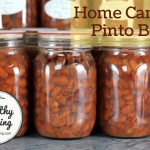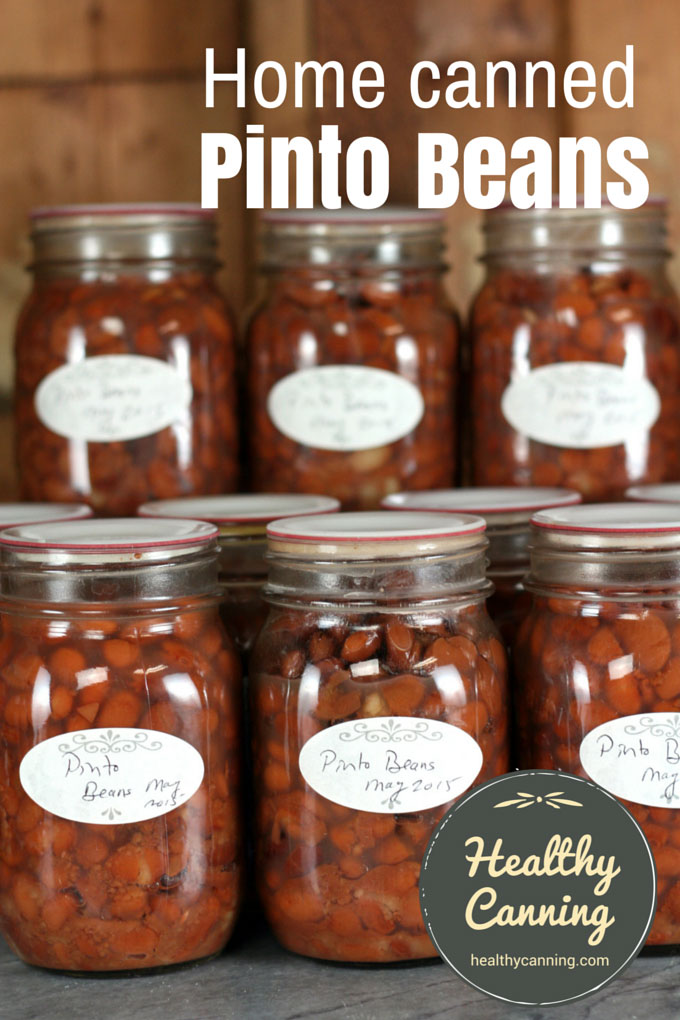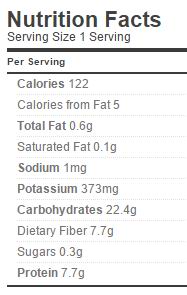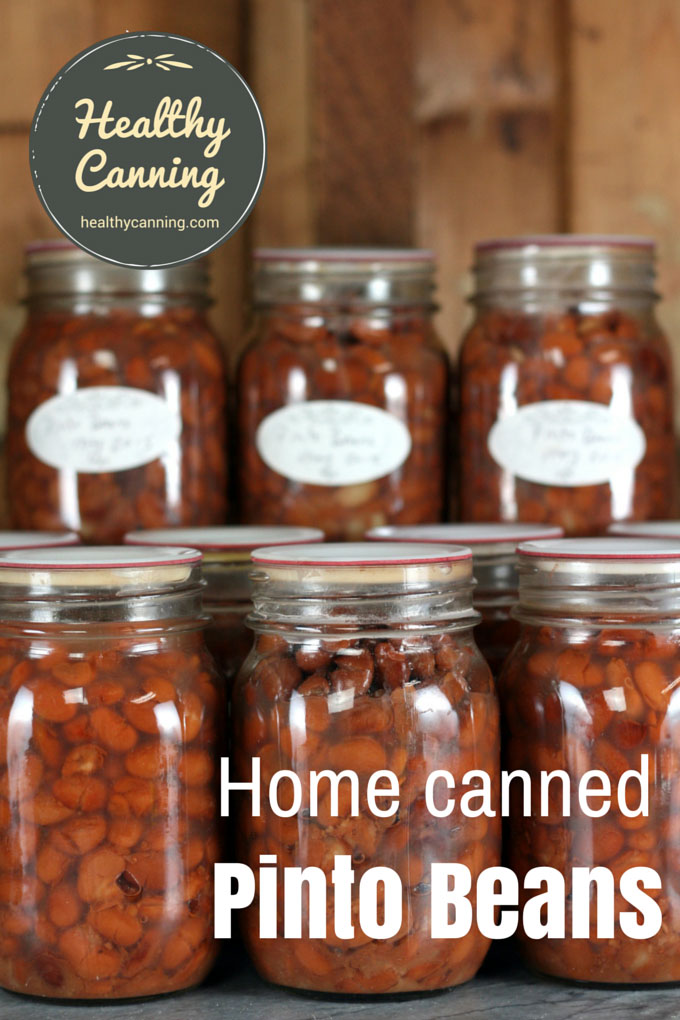Home-canned pinto beans are delicious and wonderful to have on hand.
When you can them yourself at home, you can make them without all the added salt that commercially-canned pinto beans have.
It’s nice to have jars of different sizes available so you can open just the size you need.
You can use these canned pinto beans to quickly make refried beans (recipe link.)
Quantities of dried pinto beans needed
Numbers are approximate guidelines.
- Allow 175 g (6 oz) dried pinto beans per ½ litre (US pint) jar.
- Allow 350 g (¾ lbs) dried pinto beans per litre (US quart) jar.
The recipe
Jar size choices: ¼ litre (½ US pint) or ½ litre (1 US pint) or 1 litre (US quart)
Processing method: Pressure canning only
Yield: varies
Headspace: 3 cm (1 inch)
Processing pressure: 10 lbs (69 kPa) weighted gauge, 11 lbs (76 kpa) dial gauge (adjust pressure for your altitude when over 300 metres / 1000 feet)
Processing time: Half-litres (pints) 75 minutes; litres (quarts) 90 minutes

Canning pinto beans
Ingredients
- pinto beans (dried)
- water
Instructions
- Either (a) long-soak the dried pinto beans overnight covered with water, OR (b) quick-soak by covering them with water in a saucepan, bring to a boil, boil 2 minutes and let stand for an hour.
- However the beans were soaked, drain and discard the soaking water.
- Put in a pot, cover with fresh water, boil 30 minutes.
- Pack in jars: quarter-litre (½ US pint) or half-litre (1 US pint) or 1 litre (US quart)
- Leave 3 cm (1 inch) headspace.
- OPTIONAL: Add a pinch of pickling salt or non-bitter, non-clouding salt sub.
- Top up each jar with clean boiling water (such as from a kettle, for instance) or with the water you just boiled them in, maintaining headspace.
- Debubble; adjust headspace.
- Wipe jar rims.
- Put lids on.
- Processing pressure: 10 lbs (69 kPa) weighted gauge, 11 lbs (76 kpa) dial gauge (adjust pressure for your altitude when over 300 metres / 1000 feet)
- Processing time: quarter-litre (½ US pint) 75 minutes; half-litre (1 US pint) 75 minutes; 1 litre (US quart) 90 minutes.
Nutrition
Processing guidelines below are for weighted-gauge pressure canner. See also if applicable: Dial-gauge pressures.
| Jar Size | Time | 0 to 300 m (0 - 1000 feet) pressure | Above 300 m (1000 ft) pressure | |
|---|---|---|---|---|
| ¼ litre (½ US pint) | 75 mins | 10 lbs | 15 lbs | |
| ½ litre (1 US pint) | 75 mins | 10 lbs | 15 lbs | |
| 1 litre (1 US quart) | 90 mins | 10 lbs | 15 lbs |
Reference information
How to pressure can.
When pressure canning, you must adjust the pressure for your altitude.
More information about Salt-Free Canning in general.
Recipe notes
- The USDA guidelines don’t mention the smaller ¼ litre (½ US pint) size jar, but it’s fine to do so, and it’s really handy to have that smaller 1 cup size for mashing into dips and for recipes, etc. It just has to have the same processing time as the next tested size up.
- The beans must be partially rehydrated by the methods described before going into the jars. It is not safe to put dried beans in a jar and fill with water, nor will the quality of the product be good either.
Recipe source
Beans or Peas – Shelled, Dried: All Varieties. In: United States Department of Agriculture (USDA). Complete guide to home canning. Agriculture information bulletin No. 539. 2015. Page 4-5.
Modifications: none
Cooking with canning
Nutrition
Serving size: ½ cup (100 g)
Per ½ cup / 100 g: 122 calories, 1 mg sodium
Weight Watchers PointsPlus®: ½ cup / 100 g = 3 points; 1 cup / 200 g = 5 points
* Nutrition info provided by https://caloriecount.about.com
* PointsPlus™ calculated by healthycanning.com. Not endorsed by Weight Watchers® International, Inc, which is the owner of the PointsPlus® registered trademark.




Melissa
I would like to know if it is possible to add the ham hock to the beans when they are canned? Or is that out of the scope? I know you can add some seasoning, but I didn’t know about meat.
Nikki
When pre-cooking, can you add seasonings other than salt? I usually add oregano and cumin to my beans. I also typically add garlic, bell pepper and onion. Can I add these ingredients when pre-cooking and then pressure can accordingly?
Healthy Canning
The dry seasonings are all pre authorized as it were, for sure. (See: Safe Tweaking of recipes). As for adding veg, check with a Master Food Preservers help group.
Michelle Prater
After canning and cooling my beans have soaked up all the water in the jar. The jars are sealed and the beans look good bit there is very little liquid left. What did I do wrong and are they on to keep?
Healthy Canning
That can happen from time to time. It can depend on how old the beans are, and oftentimes we don’t know how long they sat in warehouses before reaching us. This is part of the reason for the USDA being so explicit about wanting the pre-soak and pre-cook of the beans before canning. Your beans are fine.
Crystal
Why can you can pinto beans but not refried beans?
Healthy Canning
Too dense. Make your refried beans from the canned beans. Directions here: https://www.healthycanning.com/refried-beans-from-home-canning/
Deana
Can you pressure cook the pinto beans As you normally would, with all the seasoning and then can using 10pound pressure about 15-20 minutes?
Healthy Canning
The directions are seriously meant to be followed just as written, in a certified pressure canner. No shortcuts, and no other alternative ways of canning.
Jessica Allen
Could I use an instant pot to do this?
Healthy Canning
Absolutely not. If you do not have a pressure canner, you can freeze cooked beans instead.
New to canning
Just a quick question could you please tell me if you could have your beans already cooked and have them good and hot and have your jars washed and hot and just can beans that way would they keep
Healthy Canning
No, they would probably go bad fast, and in doing so they would be doing you a favour, because otherwise you run the risk of botulism. If you can’t pressure can them properly, then just keep them as dry and cook up quickly as needed in a regular pressure cooker.
Lauren Brown
Hi There –
Where did you get this information you quoted below? I always pressure can dried beans that have been rinsed and they are fine. If you presoak or precook them, they are often mushy and inedible. Is this a fact, or merely your opinion?
“The beans must be partially rehydrated by the methods described before going into the jars. It is not safe to put dried beans in a jar and fill with water, nor will the quality of the product be good either.”
Healthy Canning
Hi Lauren, Healthy Canning promotes research-based safe canning methods as developed by the USDA. You can find your method listed under “false shortcuts” here: https://www.healthycanning.com/canning-beans/#false-short-cuts
Your “method” is highly recommended against by all home canning specialists and labelled as unsafe.
Paula
how full should the jars be for dry pintos
Healthy Canning
You do not put the pinto beans in dry, you put them in prepared as directed.
Jeanie
I haven canned beans yet but I have found that some lighter colored pintos cook in a couple of hours to perfect soup consistency without soaking. The darker ones I soak and some times they still take all day to cook. I’m wondering if the lighter ones could be done without presoaking?
Healthy Canning
The presoaking is mandatory for safety.
Kari
Is it okay to can the beans with chicken broth instead of water? Will it affect the processing time?
Healthy Canning
Hi Kari, I actually do not have an answer to that. I know people on the Internet say they do, but Healthy Canning likes to have a citation from a reputable source for everything as backup for statements, and I don’t recall seeing it mentioned anywhere. But I’m going to refer you to a Master Food Preserver’s group, who may be able to help. The group is here on Facebook: https://www.facebook.com/UCCE-Master-Food-Preservers-of-El-Dorado-County-456649991034665 . I’d be interested to hear what they say.